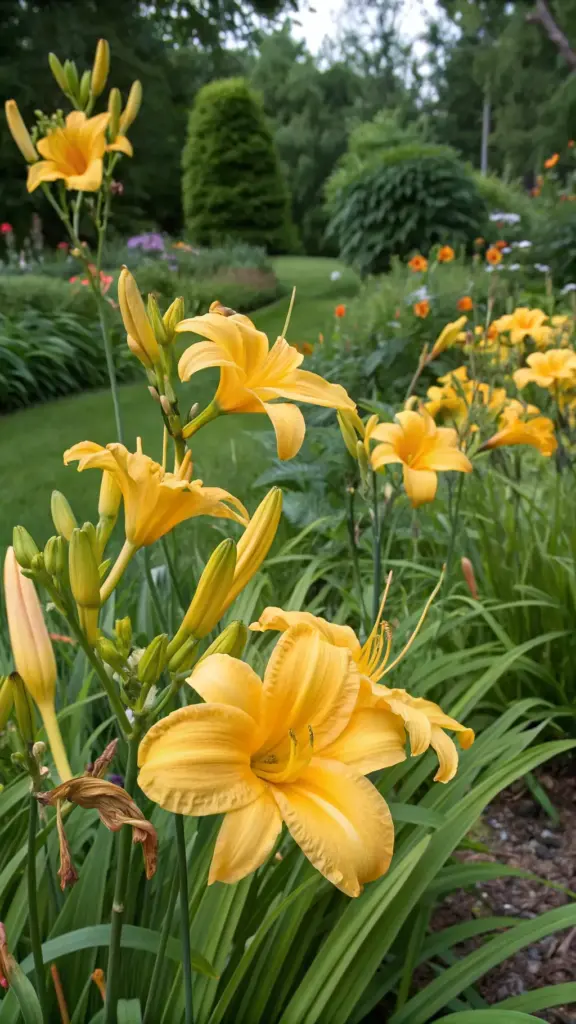7. Daylilies: Versatile and Vibrant

If you’re looking for a plant that’s as hardworking as it is beautiful, look no further than daylilies. These versatile blooms are like the Swiss Army knife of the garden world—they’re low-maintenance, adaptable, and come in a rainbow of colors. I’ll never forget the first time I tasted a daylily petal (yes, they’re edible!) in a salad. It was like discovering a hidden superpower I didn’t know my garden had. Let’s dive into the best daylily varieties for Zone 5, how to use them for stunning borders and pathways, and why their petals deserve a spot in your kitchen.
Top Daylily Varieties Suited for Zone 5 Climates
When it comes to daylilies, not all varieties are created equal—especially in Zone 5’s chilly winters. Trust me, I’ve tried a few duds before finding the real winners.
One of my all-time favorites is ‘Stella de Oro’. This little powerhouse blooms nonstop from early summer through fall, and its golden-yellow flowers are like sunshine on a stem. Another gem is ‘Happy Returns’, which has soft butter-yellow blooms and is just as reliable as ‘Stella de Oro’.
For something a bit more dramatic, try ‘Purple D’Oro’ or ‘Crimson Pirate’. These varieties bring deep, rich colors that pop against green foliage. And here’s a pro tip: look for reblooming varieties if you want continuous color throughout the season. They might cost a bit more upfront, but they’re worth every penny.
Design Ideas for Creating Borders and Pathways
Now, let’s talk about how to use daylilies to create jaw-dropping borders and pathways. One year, I decided to line my garden path with ‘Stella de Oro’, and it completely transformed the space. The vibrant yellow blooms made the path feel inviting and cheerful, even on cloudy days.
Here’s a trick I learned: plant daylilies in clusters rather than single rows. This creates a lush, full look that feels intentional and polished. For borders, mix them with lower-growing plants like lavender or dianthus to add layers and texture.
Another idea? Use taller varieties like ‘Autumn Minaret’ as a natural fence around vegetable gardens or seating areas. Not only do they provide privacy, but they also attract pollinators, making your garden buzz with life. And don’t forget to stagger their placement along pathways for a meandering, organic feel—it’s like walking through a living art gallery.
Health Benefits of Edible Daylily Petals in Recipes
Okay, here’s where things get really fun. Did you know that daylily petals are edible? Yep, these vibrant blooms aren’t just for show—they’re packed with nutrients like vitamin C, beta-carotene, and antioxidants.
I remember tossing a handful of fresh petals into a summer salad one evening, and it was such a hit that I’ve been using them ever since. Their mild, slightly sweet flavor pairs beautifully with citrus dressings or as a garnish for soups and stir-fries.
Pro tip: only use the petals, not the base of the flower, as it can be bitter. And always make sure the daylilies haven’t been treated with pesticides. Oh, and here’s a fun recipe idea: try stuffing whole daylily buds with cream cheese, breading them, and frying them for a unique appetizer. Your guests will think you’re some kind of culinary wizard!
Alright, before we wrap this up, here’s a little teaser: Up next, we’re diving into sedum, the rock garden wonders that add architectural interest to any space. Want to know how to combine sedum with succulents for modern aesthetics and create a maintenance-free oasis? Click the next button below to find out! 🌼









GIPHY App Key not set. Please check settings